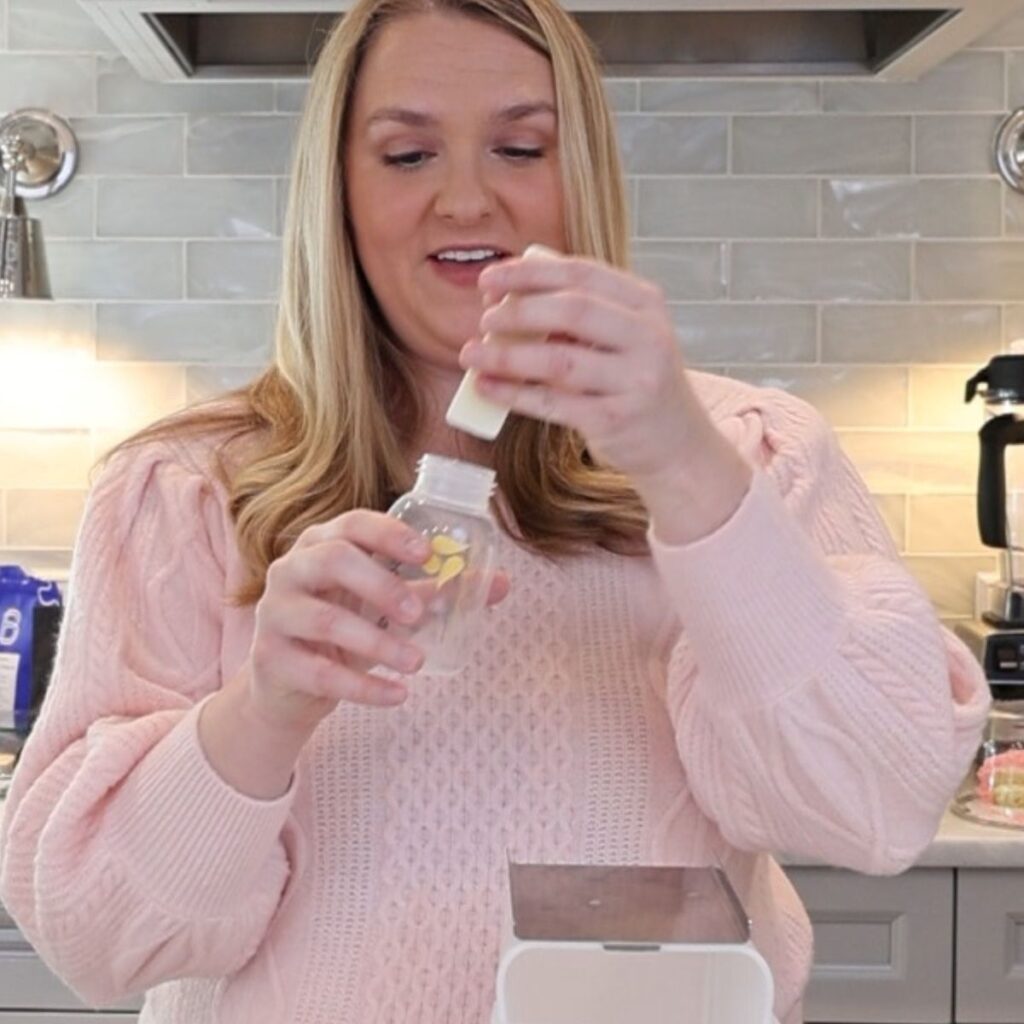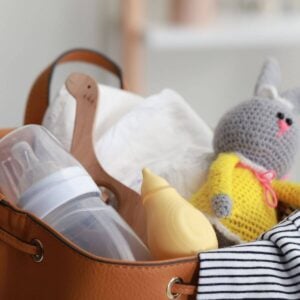Storing and organizing breast milk in the freezer can be a challenging task, and it’s not an extra headache new moms need! But if you plan to breastfeed while working or taking time away from baby, then having a reliable and efficient freezer storage solution is essential.
In this article, I’m sharing my personal experience using different options for breast milk freezer storage, providing essential tips for freezing breast milk, and helping you find the best milk tray or breast milk bag for your needs.
These handy tools not only make it easy to store and organize breast milk but also ensure that your milk stays fresh and free of contamination.
Keep reading, friend, to learn how to make your breastfeeding journey easier and more enjoyable with our ultimate breast milk storage solutions!
A huge thanks to Fairhaven Health for sponsoring this article. I love their Milkies products for breastfeeding moms—they take out so much of the guesswork when it comes to milk storage, and I love how their freezer storage systems help my freezer stay more organized without bags of milk falling everywhere.

This site contains affiliate links, meaning that we earn a small commission for purchases made through our site. We only recommend products we personally use, love, or have thoroughly vetted.
- How To Store Breast Milk in the Freezer
- Breast Milk Freezer Storage: Freezer Trays or Milk Bags?
- What’s The Difference Between Milk Trays and Milk Bags?
- Freezer Space
- Winner: Freezer Space
- Milk Trays
- Milk Bags
- Ease of Unfreezing Breast Milk
- Winner: Ease of Unfreezing
- Milk Trays
- Milk Bags
- Wastes Less Milk
- Winner: Wastes Less Milk
- Milk Trays
- Milk Bags
- Breast Milk Storage With the Easiest Cleanup
- Winner: Easiest Cleanup
- Milk Trays
- Milk Bags
- Most Environmentally Friendly
- Winner: Most Environmentally Friendly
- Milk Trays
- Milk Bags
- Best For Use Beyond Breastfeeding
- Winner: Use Beyond Breastfeeding
- Milk Trays
- Milk Bags
- Best Overall: Freezer Bags Vs. Milk Trays
- Breast Milk Freezer Storage Contest
- How to Thaw Frozen Breast Milk
- Freezing Breast Milk Summary
How To Store Breast Milk in the Freezer
Storing breast milk in the freezer can be a huge relief to new parents. It helps ensure baby has access to breast milk even when mom is away or unable to breastfeed, and it gives mama some much-needed breathing room to leave the house, take a nap, or just have time to herself.
Proper storage is essential to maintain the nutritional value of breast milk and prevent contamination, but it doesn’t need to be scary or overwhelming. Simple breast milk freezer storage solutions will give you a great way to build that milk stockpile for baby without worrying that you’re doing something wrong.
Breast Milk Storage Safety: What You Need to Know
The CDC provides clear guidelines for storing breast milk, and the good news is, the guidelines are easy to follow. Here’s what you need to know:
- Always pump milk with clean hands and clean pump parts. Keep your breast milk tubing clean to prevent mold buildup (most Spectra pumps are designed to avoid this problem!).
- Use breast milk storage bags or milk trays designed specifically for milk storage. (Avoid plastics containing bisphenol A (BPA) (recycle symbol #7).
- Store milk in the freezer at 0 degrees Fahrenheit (-18 degrees Celsius) or colder.
- Use milk within 1 year of freezing (6 months is ideal; if planning to store for 1 year, it’s best to store frozen breast milk in a deep freezer).
- Thaw under warm or room temp water or in the refrigerator overnight. (Never heat breast milk in the microwave or on the stove.)
- Never refreeze human breast milk after it has been thawed
Now let’s be real for a minute, friend. Reading things like CDC guidelines can be scary because it always makes us imagine the worst. But the reality is, with a basic understanding of safe milk storage practices (meaning, the ones outlined above), freezing breast milk is an easy and effective way to feed your baby.
So try not to get wrapped up in too many details.
Know the basics, practice good hygiene, and enjoy the freedom that you develop when you store breast milk in the freezer.
Frozen Breast Milk Storage Tips
I’ve spent more than 2 years of my life storing breast milk for my babies, and the first time, I was exclusively pumping. So I understand the labor of love that pumping milk for your baby can be, and I’ve developed some amazing tips and tricks over the years to make the process a little easier for you.
Here are my tried-and-true tips that you really need to know.
- Choose the right storage container: Use breast milk storage bags or milk trays that are specifically designed for freezing breast milk. I’ll walk you through the difference later in this article and help you decide which one is best for you.
- Label and date your breast milk: Label your milk with the date it was expressed and the amount of milk in the container. This will help you keep track of the freshness of the milk and ensure that you use the oldest milk first.
- Use the Milkies Storage Systems: The Milkies Freeze Breast Milk Storage System is amazing for 2 main reasons. First, it prevents bags from spilling all over your freezer (for the win!) Second, it makes it easy to always grab the oldest bag first, making milk storage safety a breeze.
- Store pump parts in the refrigerator for up to 24 hours: You heard me, friend. You don’t have to wash your pump parts every single time you hook up to pump as long as you store them in the refrigerator. While fresh breast milk is good in the refrigerator for up to 4 days, it’s better to only store used pump parts for up to 1 day because they’re constantly going in and out of the refrigerator and thus are not at a stable temperature.
- Have a devoted bin for washing bottles and pump parts: Instead of tossing parts directly in the sink where there’s more bacteria, have a dedicated bin only for baby items and wash directly in that bin.
- Store breast milk in the back of the freezer: Store breast milk in the back of the freezer where the temperature is the most constant. Avoid storing milk in the freezer door, as the temperature fluctuates more frequently in that area.
These simple tips make storing milk a breeze, and they’ll save you a lot of time and worry.
Breast Milk Freezer Storage: Freezer Trays or Milk Bags?
So which option is better for freezing your milk–milk trays or bags?
I’ve tested both—milk bags (throw away; no extra cleanup) or milk trays (never waste an ounce, but have to wash them)–and am going to give you all the pros and cons so you can decide which is best for your needs.
What’s The Difference Between Milk Trays and Milk Bags?
A milk tray looks a lot like an ice cube tray, but with a few main differences:
- It has a lid—ideal for keeping frozen milk or baby food clean
- It’s larger, with cavities designed to hold 1oz of milk, so you can easily thaw by the ounce
- It’s flexible, so it’s easy to get the milk out
With a milk bag, you pour your milk into the bag, place the bag in the freezer, and then thaw the whole bag when you’re ready to use the milk.
Freezer Space
I can fit about 8 bags with 7oz of milk each in the freezer caddy, so that’s 56 oz of milk total. Each milk tray holds 8oz of milk, so I would need 7 trays stacked on top of each other to equal this height, but it takes up more space in length, so the bags take up less space.
You can remove the sticks and save them in a ziplock freezer bag, and that will take up a little less space, but a one-gallon bag can usually only store about 30 ounces, so that’s still taking up a larger surface area for less milk.
Winner: Freezer Space
Milk Trays
Milk Bags
Ease of Unfreezing Breast Milk
This one is tricky because it depends on how you want to unfreeze it.
Milk trays allow you to drop individual one-ounce cubes of milk into any bottle top, which is amazing. No milk is spilled or lost because it goes into the bottle frozen.

But then, you have to let it melt and warm, either in the fridge overnight or in a bottle warmer or warm water. Because you can’t fit 8 sticks in most bottles, it’s hard to fill a full 8oz bottle using the trays. This is handled pretty simply by just adding sticks to the bottle while it’s in the warmer once the other sticks have started melting, but personally, I want to put it in and walk away.
That’s why I prefer breast milk storage bags for big bottles of milk. Bags can’t go into a bottle until they’re unfrozen, so you can leave them in the refrigerator overnight (mine usually take 24-36 hours to thaw completely on their own), or you can thaw them in under lukewarm running water.
Winner: Ease of Unfreezing
Milk Trays
Milk Bags
Wastes Less Milk
When you transfer milk from a frozen bag into a bottle, you have to first thaw the milk, then pour. This sometimes leads to spilling, and sometimes the fattier milk stays stuck to the inside of the bag.
But when using milk trays, not a drop is wasted. The whole frozen stick of milk goes directly into the bottle and is thawed in the bottle.
Winner: Wastes Less Milk
Milk Trays
Milk Bags
Breast Milk Storage With the Easiest Cleanup
Neither really requires much cleanup. In theory, milk trays require slightly more clean up because you do have to wash the trays (hand wash only—no dishwasher!) But, since you’ll have occasional spills when using bags, you’ll find yourself wiping the counter up more after transferring from bags.
Roughly equal, but . . .
Winner: Easiest Cleanup
Milk Trays
Milk Bags
Most Environmentally Friendly
Trays are the definite winner here. They’re zero waste, but of course, you do use water to heat the milk. But that’s true of both, while bags produce plastic waste.
Winner: Most Environmentally Friendly
Milk Trays
Milk Bags
Best For Use Beyond Breastfeeding
Trays win here. My favorite thing to do is to store homemade baby food in them.
Whether you’re buying food in jars, doing baby-led weaning, or making purees at home (most of us are a combination), you’ll likely find that you make baby food at some point. For instance, if I make sweet potatoes, I always blend some with breast milk for baby food. Or if bananas are close to going bad, I can mush them up with some milk to store for Branham.
I LOVE using these trays to store the food in pre-measured, small serving sizes without taking up too much space in the fridge.
Winner: Use Beyond Breastfeeding
Milk Trays
Milk Bags
Best Overall: Freezer Bags Vs. Milk Trays
It depends on your space and your preferences. Checking off on our list, they’re about equal. The bags take up less space on the whole, require less cleaning, and are easier to unfreeze. The bags waste less milk, produce less waste, and can be used well beyond breastfeeding.
Personally, I like bags for full bottles, but trays when baby is young enough to need fewer ounces OR old enough that they aren’t drinking as much milk, OR you’re mixing it.
I don’t love having to add milk sticks while I’m actively thawing, which is really the only way to use the trays and have enough straight breast milk to fill 6-8 oz bottles. Right now, Branham is 1, and we’re mixing breast milk with cow’s milk, but I still like for her to have mostly breast milk before bed because it seems to keep her full better.
So I like to have bags if someone else is putting her to bed at night, but otherwise, the trays are PERFECT adding a couple of ounces of breast milk to her daily cow’s milk.
Breast Milk Freezer Storage Contest
Milk Trays
Milk Bags
How to Thaw Frozen Breast Milk
No matter which way you choose to freeze your breast milk, thawing is an essential part of the process. I like to thaw frozen bags in the refrigerator overnight (usually takes about 24 hours for a bag to fully thaw in my refrigerator) and put frozen sticks in a bottle in the warmer.
However you choose to thaw your breast milk, though, there are a few basic tips worth knowing.
- Thaw the milk slowly: Whether in the refrigerator, a bottle warmer, or just a bowl of warm water, thaw the milk slowly to help it maintain its full nutrient value.
- Just say no to the microwave: Microwaving breast milk can destroy nutrients and create hot spots that can burn baby’s mouth.
- Gently swirl the milk: Once the milk has thawed, gently swirl it to mix the fattier cream with the lighter liquid. Avoid shaking, which can damage the milk’s nutritional properties.
- Use thawed breast milk within 24 hours.
Freezing Breast Milk Summary
Freezing breast milk is an easy way for breastfeeding parents to be able to nourish their babies while also having some personal space.
To freeze breast milk, use clean hands and containers to pour the freshly-pumped breast milk into either breast milk bags or milk trays. Breast milk bags are small plastic bags that are made specifically for human milk so that they’re free from bisphenol a (aka BPA free).
Follow all milk storage guidelines to preserve the integrity of the milk, maintain its healthy nutrient enzymes, and prevent the build-up of bacteria.
Labeling milk with the date it was expressed and the amount in a storage container will make your life much easier in the long run.
To make your milk storage experience as easy as possible, check out the Milkies Freeze Breast Milk Storage System and Milkies Milk Trays.










